-
Title
-
An Experimental and Analytical Investigation of Hypersonic Inlet Boundary Layers
-
Date
-
1965
-
Index Abstract
-
Coming Soon
-
Photo Quality
-
Complete
-
Report Number
-
AFFDL TR 65-123 Volume 1
-
Corporate Author
-
Lockheed-California Company
-
Laboratory
-
Air Force Flight Dynamics Laboratory
-
Extent
-
110
-
NTRL Accession Number
-
AD621343
-
Identifier
-
AD0621343
-
AD0621343
-
Access Rights
-
Notice(s)
-
Distribution Classification
-
1
-
Contract
-
AF 33(657)-8833
-
DoD Project
-
1366
-
DoD Task
-
136605
-
DTIC Record Exists
-
No
-
Distribution Change Authority Correspondence
-
None
-
Special Scanning Requirements
-
fold out pages
-
Abstract
-
Detailed boundary layer surveys were made on four axisymmetric compression surface models simulating typical hypersonic inlet compression surfaces at free stream Mach numbers ranging from 4 to 8. The four models were designed to provide isentropic compression at design Mach numbers of 5, 6, 8 and 10. The Mach 8 design model had provisions for wall cooling. Quantitative heat transfer measurements were made on the Mach 8 model at free stream Mach numbers of 5, 6, and 8. Two existing turbulent boundary layer theories were modified to account for the various phenomena found to be of importance in hypersonic boundary layers. Theoretical results from these methods were correlated with the experimental data. A significant observation of the present program is the powerful favorable effect of centrifugal force phenomena on boundary layer development in continuous adverse pressure gradients. It was found that these effects become more pronounced with increasing Mach number and reductions in free stream Reynolds number.
-
Report Availability
-
Full text available
-
Date Issued
-
1965-08
-
Provenance
-
Lockheed Martin Missiles & Fire Control
-
Type
-
report
-
Format
-
1 online resource
-
Subject
-
Carburetor Air Scoops
-
Turbulent Boundary Layer
-
Hypersonic Characteristics
-
Centrifugal Fields
-
Model Tests
-
Cooling
-
Wind Tunnel Models
-
Compressible Flow
-
Surfaces
-
Heat Transfer
-
Creator
-
Stroud, J. F.
-
Miller, L. D.
